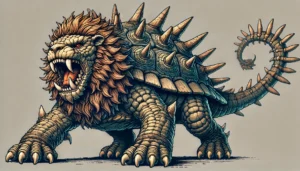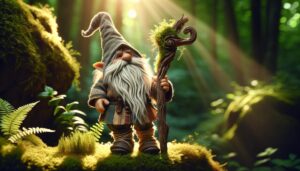Table of Contents
In the heart of the dense, primeval forests of Eastern Europe, a mystical and enigmatic creature known as the Leshy lurks. This elusive and ancient being is a staple in Slavic folklore, captivating the imagination of those who dare to venture deep into the woods.
Origins and Family
The Leshy, often spelled as “Leshii” or “Lesovik,” is a creature of the forest and a guardian of the wilderness in Slavic folklore. Furthermore, its origins trace back to the pagan beliefs of the ancient Slavic peoples who inhabited the vast forests of Eastern Europe. Within these cultures, they regarded the Leshy as a spirit of the woods, and they intertwined its existence with the natural world.
When it comes to familial connections within the realm of mythical creatures, the Leshy often associates itself with other forest spirits and beings. Some legends suggest that it is related to the Rusalka, a water nymph, while others claim that it shares kinship with the Domovoi, a household spirit. These connections reflect the intricate web of supernatural entities that the Slavic people believed inhabited their world.
Appearance
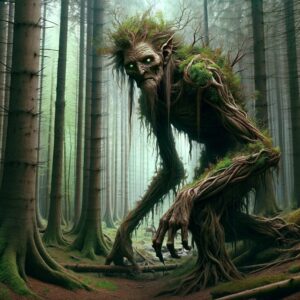
The Leshy is a shapeshifter, a master of camouflage, and a true chameleon of the forest. Its appearance can vary greatly, making it exceptionally challenging to spot. However, people often attribute certain characteristics to the Leshy in its most common form.
While the Leshy can appear as a normal human, it often bears certain peculiarities that betray its true nature. It may have an unnatural, elongated neck or limbs that seem to stretch into the branches of the tallest trees. Some stories tell of Leshy’s ability to change its size at will, growing as tall as the ancient oaks or shrinking to the size of a blade of grass.
Abilities
The Leshy’s powers are as diverse as the forests it calls home. This enigmatic creature possesses a range of abilities that highlight its role as a guardian of the wilderness:
Shape-shifting: The Leshy can transform into various forest animals or even inanimate objects, allowing it to move stealthily and remain hidden from intruders.
Voice Mimicry: It can imitate the sounds of birds, animals, or even people, luring unsuspecting wanderers deeper into the woods.
Telepathy: It is said that the Leshy possesses the ability to communicate with animals and control them, turning them into its loyal spies.
Distortion of Space: It can manipulate the forest landscape, making travelers lose their way by altering the paths and landmarks in the woods.
Invisibility: At times, the Leshy can become completely invisible, rendering itself virtually undetectable.
Weather Manipulation: Some legends attribute control over the weather to the Leshy, allowing it to conjure storms, fog, or other natural phenomena to disorient its victims.
Symbols
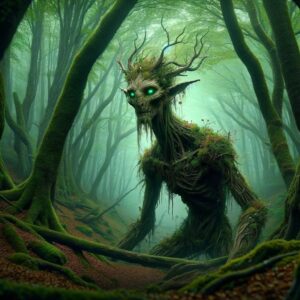
Leaves and Trees: Leaves and trees, particularly the oak, are common symbols representing the Leshy. They signify its dominion over the woodland realm.
Green Eyes: Green, glowing eyes are a recurring motif in depictions of the Leshy, symbolizing its otherworldly nature and the magic that resides within.
Moss and Twigs: These elements are often incorporated into visual representations of the Leshy, emphasizing its intertwining with the forest.
Animal Companions: Sometimes, people use symbols of forest animals like wolves, bears, and owls to represent the Leshy’s ability to communicate with and command these creatures.
Related Myths and Stories
Throughout the centuries, people have woven countless myths and stories around the Leshy, each reflecting different aspects of its character and the folklore of the region. Here are some of the most intriguing tales associated with this elusive forest guardian:
The Lost Traveler
In one of the most prevalent legends featuring the Leshy, a hapless traveler finds themselves wandering deep within the dense and foreboding woods. As the traveler ventures further into the heart of the forest, an eerie feeling of disorientation gradually envelops them. Unbeknownst to the traveler, this disorientation is the cunning work of the Leshy, a mystical forest spirit known for its trickster tendencies.
With supernatural powers at its disposal, the Leshy plays a nefarious game with the traveler’s sense of direction. It leads the bewildered wanderer in endless circles, causing their once-confident pathfinding abilities to crumble into frustration and despair. The forest, under the Leshy’s command, seems to shift and change, making every tree and trail appear identical.
Yet, in a twist of fate, the Leshy, embodying its enigmatic nature, eventually relents. Recognizing the traveler’s vulnerability, it transforms from a trickster into a benevolent protector of the forest. With a knowing smile, the Leshy guides the weary traveler back to safety, teaching them a valuable lesson about the wilderness and emphasizing its dual role as both a mischievous entity and a guardian of the woods.
The Leshy’s Marriage
In certain captivating tales, the Leshy emerges as a creature teeming with desires and emotions, thus transcending its usual enigmatic persona. Within these legends, an extraordinary narrative unfolds as the Leshy, with its otherworldly charm, becomes infatuated with a human being. This deep and inexplicable affection blossoms into a profound love that knows no bounds. Consequently, it ultimately culminates in a remarkable union between the forest spirit and the mortal.
Their union ushers in a series of extraordinary adventures and challenges, thereby unraveling the intricate web between the human and supernatural realms. Furthermore, the Leshy’s love for the human transcends mere affection; it signifies a bridge between two worlds, each with its own set of rules and mysteries. Consequently, the couple navigates through a surreal landscape, filled with enchantments, trials, and tests of their devotion.
These stories not only explore the passionate and forbidden love between the Leshy and the human but also delve into the fragile boundary between the ordinary and the extraordinary. They underscore the idea that love, when unbridled by convention and difference, has the power to transcend the realms of possibility, bringing together beings from divergent worlds to create an unforgettable saga of love, adventure, and the timeless clash between the human and supernatural domains.
The Forest’s Guardian
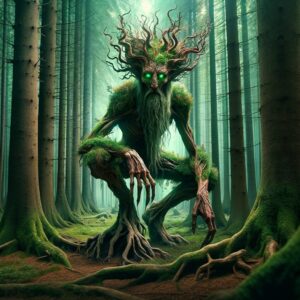
In the lore and legends surrounding the Leshy, this mystical forest spirit takes on a profound role as the unwavering protector of the forest and all its inhabitants. Furthermore, within these captivating narratives, the Leshy’s dedication to safeguarding the natural world is an ever-present theme, demonstrating its profound commitment to maintaining the delicate balance of nature.
The Leshy is not merely a passive observer; it actively seeks out and punishes those who dare to harm the woodland. When humans or creatures of the forest engage in activities that disrupt the harmony of the ecosystem, the Leshy emerges from the shadows, wielding its supernatural powers. It uses its deep connection with the forest to inflict consequences upon those who have transgressed against it.
In these tales, the punishments meted out by the Leshy are not always violent or malevolent; instead, they serve as lessons to deter further harm. The forest spirit ensures that those who threaten the natural order of things are taught to respect the environment and its delicate equilibrium.
These stories underscore the Leshy’s indispensable role as a guardian of the natural world, emphasizing its dedication to preserving the wilderness, nurturing the flora and fauna, and safeguarding the intricate web of life within the forest’s embrace. Moreover, Leshy’s actions exemplify the timeless connection between folklore and the imperative to protect our precious natural resources.
The Leshy’s Wrath
The Leshy’s protective instincts surge to the forefront and unleash its wrath upon intruders in tales where the forest mistreats or disrespects it. This aspect of the Leshy’s character highlights its role as a formidable guardian of the natural world, one not to be trifled with.
When faced with humans or creatures who have transgressed against the sanctity of the woodland, the Leshy harnesses its extraordinary powers to create a terrifying spectacle. It can conjure thick, disorienting mists that swallow intruders whole, enveloping them in a suffocating shroud of confusion. The forest itself seems to come alive under the Leshy’s command, with trees shifting, paths vanishing, and eerie sounds echoing through the wilderness.
These disorienting displays are not meant solely to punish but also to educate. The Leshy’s anger serves as a lesson, reminding intruders of the profound importance of respecting the wilderness and the delicate balance of nature. It forces them to confront their own arrogance and ignorance, instilling a deep sense of humility and reverence for the natural world.
Similarities
In European cultures, the Green Man is a symbol representing the spirit of nature. Portrayed as a face crafted from foliage, the Green Man embodies the vitality and growth of the natural world. Similarly, like the Leshy, he safeguards the forest and protects the wilderness.
Cernunnos (Celtic Mythology): Associated with nature, animals, and the forest, Cernunnos is a Celtic god. Additionally, often depicted with antlered horns, he is revered as a guardian of the wild. Similarly, much like the Leshy, Cernunnos symbolizes the vital energy and interconnectedness of all living beings.
In Greek and Roman mythology, people know Satyrs and fauns for their wild and mischievous behavior. Typically, artists portray them as part human and part animal with goat-like features, linking them to nature and the untamed aspects of the wilderness.
Yōkai (Japanese Folklore): Japanese folklore features various yōkai (supernatural creatures) associated with forests and natural landscapes. For instance, Tengu are often connected to mountainous regions, serving as both protectors and tricksters. Similarly, Kodama are tree spirits inhabiting ancient forests, believed to bring misfortune to those who harm the trees.
Naturae (Roman Mythology): Roman mythology introduces the Naturae, also known as Nymphs, minor deities of nature. They are linked to various natural features, including forests, rivers, and mountains. Each type of Nymph possesses its own domain and plays a role in preserving the natural order.
Eloko/Eloko-ya (Central African Folklore): In Central African folklore, particularly among the Bantu peoples, the Eloko or Eloko-ya are mythical creatures. These forest-dwelling beings, small in stature, are renowned for their protective and vengeful nature. They diligently guard the forests and may punish those who harm the environment or trespass without permission.
FAQ
What does a Leshy look like?
It is typically depicted as a tall, humanoid figure with features resembling those of a forest, such as bark-like skin and sometimes horns.
What is the Leshy's role in folklore?
The Leshy is believed to be a guardian of the forest and wildlife, having the ability to communicate with and control animals.
Are there similar creatures in other mythologies?
Yes, in Celtic mythology, Cernunnos shares some similarities with the Leshy as a deity associated with nature and animals.
Can the Leshy be found in modern culture?
The Leshy continues to be a part of Slavic cultural heritage and occasionally appears in modern literature, art, and folklore studies.



